Russian Money
The official currency of the Russian Federation is the Russian rouble (Российский рубль). One rouble is made up of 100 kopecks.
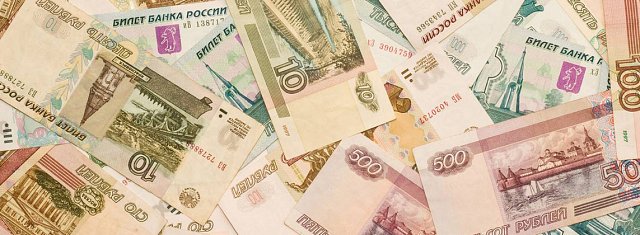
►Practicalities ►Russian Money

The rouble as unit of currency has been used in Russia since the 13th century. One theory of the origin of the word rouble is that it is derived from the Russian word for 'to chop' ('rubit') as originally a rouble was a slither chopped of a piece of silver. It is theorised that kopeck is the diminutive form of the Russian word for a 'spear' ('kopyo') as the first kopeck coins contained the image of a spear.
 The official symbol for the Russian rouble was only adopted in December 2013 and depicts a 'P' (a Russian 'R') with a horizontal cross. Usually you will see prices written as "100 руб." or sometimes just "100 р". The official ISO code for the rouble is 'RUB'.
The official symbol for the Russian rouble was only adopted in December 2013 and depicts a 'P' (a Russian 'R') with a horizontal cross. Usually you will see prices written as "100 руб." or sometimes just "100 р". The official ISO code for the rouble is 'RUB'.
Exchange rates
1 US Dollar ~ 61 Russian Roubles
1 UK Pound ~ 80 Russian Roubles
1 Euro ~ 70 Russian Roubles
RUB 5 BANKNOTE

Even though the RUB 5 banknote is still legal tender, there are practically none left in circulation so you won't be finding one in your change. The surviving ones are all in collections or kept as souvenirs. The note is green in colour and features the city of Novgorod Veliky. On the front it depicts the Millennium of Russia Monument Bell and St Sophia's Cathedral and on the back it depicts the Novgorod Kremlin.
RUB 10 BANKNOTE

Since the introduction of the RUB 10 coin, the RUB 10 banknote is also becoming rarer but you will still probably see one on your trip. They are dark-green and brown in colour and feature the city of Krasnoyarsk. The front shows the bridge over the River Yenisey and St Paraskevi Pyatnitsa's Chapel. The back has an image of the Krasnoyarsk Hydroelectric Dam. A slang term for RUB 10 is a 'desyatka'.
RUB 50 BANKNOTE

The light-blue RUB 50 banknote features St Petersburg. On its front it has an image of the monument of the personification of the River Neva (note the statue has six toes!) and the Ss Peter and Paul's Fortress can be seen in the background. The back of the note depicts the strelka of Vasilievsky Island. In common slang RUB 50 is sometimes called a 'poltinnik'.
RUB 100 BANKNOTE

The RUB 100 banknote is beige in colour and features Moscow. On the front is a depiction of the statue of the man and chariot which stands on top of the Bolshoi Theatre. The back has an image of the whole of the Bolshoi Theatre. The term 'sotka' is slang for RUB 100.
RUB 200 BANKNOTE
The new RUB 200 note is green and features the Crimean city of Sevastopol; the Monument to the Sunken Ships on the front and Khersones on the back. The choice of Sevastopol is of course rather controversial for countries who do not recognise Crimea as part of the Russian Federation.
RUB 500 BANKNOTE

The pink and purple RUB 500 note has images of both Arkhangelsk and the Solovetsky Islands. The front has a picture of the Peter the Great Monument and the River Port in Arkhangelsk, while the back depicts the Solovetsky Spaso-Preobrazhensky Monastery in the Solovetsky Islands.
RUB 1000 BANKNOTE

The RUB 1000 banknote is turquoise and slightly longer than the other notes. It contains images of the city of Yaroslavl. The Yaroslav the Wise Monument and the Our Lady of Kazan Chapel are on the front of the note. The other side depicts the beautiful Beheading of St John the Baptist Church in Tolchkov. A slang term for RUB 1000 is a 'shtuka' which literally means a 'thing'.
RUB 2000 BANKNOTE
The RUB 2,000 note. It is dark blue in colour and its front is decorated with an image of Vladivostok's Russky Bridge, while Vostochny Cosmodrome in the Amur Region is on the back.
RUB 5000 BANKNOTE

The RUB 5000 banknote was introduced in 2006 and became one of the most valuable notes in the world worth approximately EUR 120 or USD 150. It too is slightly bigger than the smaller-value notes. The Siberian city of Khabarovsk is depicted on the note. The front has images of the Nikolai Muraviev-Amursky Monument and the back depicts the bridge over the River Amur.
KOPECKS
There are currently four coins worth less than a rouble. These are the 1 and 5 kopeck coins which are made out of steal and cupronickel and the 10 and 50 kopeck coins which are now made out of tompac-plated steel, although they were previously made out of brass before 2006.
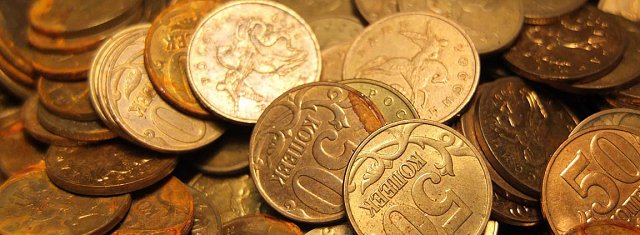
1 and 5 kopeck coins are becoming rarer as shops are more frequently rounding amounts up or down. None of these coins can actually buy you anything, and it is not unusual to see them discarded at the checkout if they are given as change. Most people also have jars of these coins at home. On the front of the coin the number of kopecks is written in figures and the back depicts an image of St George slaying the dragon.
RUB 1-5 COINS
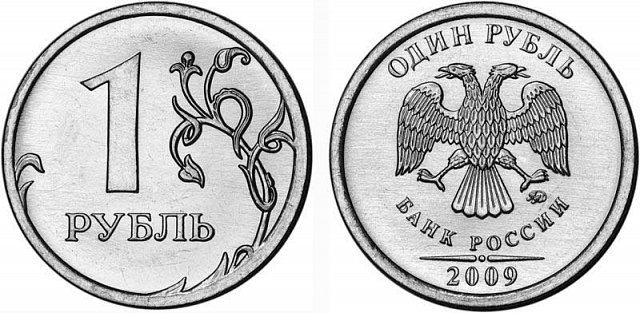
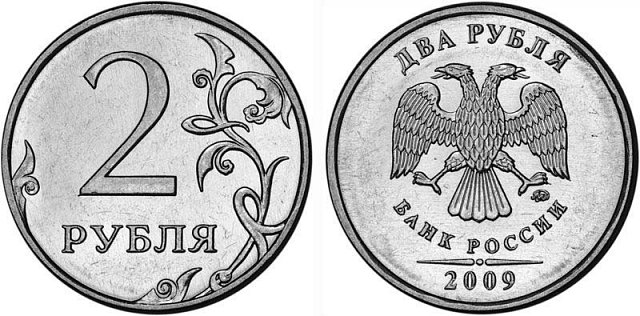
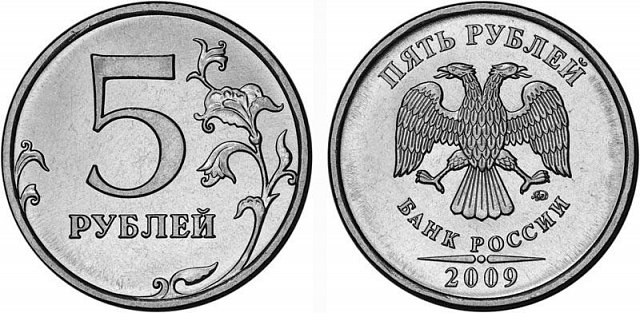
Also in circulation are coins worth RUB 1, RUB, 2 and RUB 5 which are now all made out of nickel-plated steel. The front of the coin states the value in figures and the back has an image of the Russian double-headed eagle. The coins increase in size according to the value: the RUB 1 coin is 20.5mm in diameter, the RUB 2 is 23mm and the RUB 5 is 25mm. In addition to the standard RUB 2 some special RUB 2 commemorative coins also exist, although most of these have since been taken out of circulation by collectors. Special coins include a series of coins dedicated to the 12 Hero Cities of the Soviet Union and coins featuring Yuri Gagarin.
RUB 10 COINS
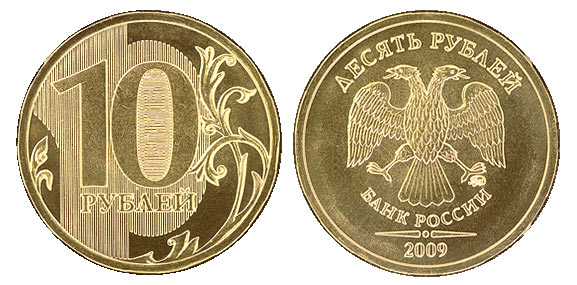
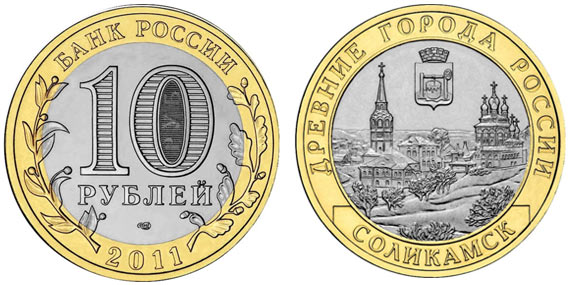

In 2010 a new RUB 10 coin was introduced into circulation. The coin is made out of brass-plated steel and is 22mm in diameter. On the front it says 10 roubles in Russian and on the back is the Russian double-headed eagle. There is also a series of special commemorative RUB 10 coins, which depict coat of arms of cities of military glory.
In addition to the new style RUB 10 coins, there is also another RUB 10 coin which you might still see in circulation although most of these have since ended up in collections. The coins are 27mm in diameter and are made out of cupronickel with a brass ring around the edge. These coins are all commemorative and there are several themes, including federal subjects and ancient cities of Russia.

►Practicalities ►Russian Money

